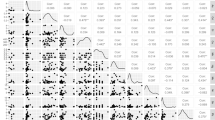Abstract
To examine longitudinal and gestational effects of mineral content in human milk, we analyzed human milk from lactating mothers of premature (PRT,n = 24, < 2000g birth weight, < 37 wk gestation) and fullterm (FT,n = 19, > 2500g, 39–41 wk gestation), living in Newfoundland, Canada. Samples were collected once a week for 8 wk with one final sample collected at 3 mo. Milk samples collected in acid-washed containers were wet ashed with concentrated HNO3, and barium, cadmium, calcium, cesium, cobalt, copper, cerium, lanthanum, magnesium, manganese, molybdenum, nickel, lead, rubidium, tin, strontium, and zinc were measured using inductively coupled plasma-mass spectrometry. Data were analyzed using standard multiple-regression procedures with correlated data analyses to take account of the relationship between successive weeks. Results indicated lower Ca and Pb in PRT milk. Calcium was the only nutritionally significant element to differ between groups. Molybdenum in both PRT and FT milk showed a definite decrease with time, suggesting that the Mo content in milk is homeostatically regulated. However, Ce, La, Ba, and Sn did not display any pattern indicative of biological regulation and potential human requirement.
Similar content being viewed by others
References
B. Lonnerdal, Effects of maternal dietary intake on human milk composition,J. Nutr. 116, 499–513 (1986).
F. H. Nielsen, Ultra-trace elements in nutrition,Ann. Rev. Nutr. 14, 21–41 (1984).
J. K. Friel and T. Alkanani, Ultra-trace elements in human milk,Life Sci. Adv. 12, 95–101 (1993).
F. H. Nielsen, Ultra-trace elements: An update, inTrace Elements in Clinical Medicine, H. Timto, ed., Springer-Verlag, Tokyo, pp. 353–360 (1990).
R. M. Feeley, R. R. Eitenmiller, J. B. Jones, Jr., and H. Barnhart, Copper, iron and zinc contents of human milk at early stages of lactation,Am. J. Clin. Nutr. 37, 443–448 (1983).
E. Vuori, S. M. Makinen, R. Kara, and P. Kuitunen, The effects of the dietary intakes of copper, iron, manganese, and zinc on the trace element content of human milk,Am. J. Clin. Nutr. 33, 227–231, (1980).
G. H. Anderson, Human milk feeding,Pediatr. Clin. North Am. 32(2), 335–353 (1985).
C. E. Casey, M. C. Neville, and K. M. Hambidge, Studies in human lactation: secretion of zinc, copper and manganese in human milk,Am. J. Clin. Nutr. 49, 773–785 (1989).
S. F. Durrant and N. I. Ward, Multi-elemental analysis of human milk by inductively coupled plasma-source mass spectrometry: implications for infant health,J. Microsc. Anal. 5, 111–126 (1989).
WHO/IAEA,Minor and Trace Elements in Breast Milk, World Health Organization Geneva (1989).
S. Atkinson, Effects of gestational age at delivery on human milk components, inHandbook of Milk Composition, R. G. Jensen, ed., Academic, San Diego, pp. 222–236 (1995).
S. Caroli, A. Alimonti, P. D. Femmine, F. Petrucci, O. Senofonte, and N. Vilante, Role of inductively coupled plasma emission spectrometry in the assessment of reference values for trace elements in biological matrices,J. Analyt. At. Spec. 7, 859–864 (1992).
R. M. Parr, E. M. DeMaeyer, V. G. Iyengar, A. R. Byrne, G. F. Kirkbright, G. Schoch, et al., Minor and trace elements in human milk from Guatemala, Hungary, Nigeria, Philippines, Sweden and Zaire,Biol. Trace Element 29, 51–75 (1991).
T. Alkanani, J. K. Friel, S. E. Jackson, and H. P. Longerich, Comparison between digestion procedures for the multi elemental analysis of milk by inductively coupled plasma mass spectrometry,J. Agric. Food Chem. 42, 1965–1970 (1994).
J. K. Friel, C. S. Skinner, S. E. Jackson, and H. P. Longerich, Analysis of biological reference materials, prepared by microwave dissolution, using inductively coupled plasma mass spectrometry,Analyst 115, 269–273 (1990).
R. H. Jones,Longitudinal Data and Serial Correlation: A State-Space Approach, Chapman & Hall, London(1993).
N. H. Nie, C. H. Hull, J. G. Jenkins, K. Steinbrennar, and D. H. Bent,Statistical Package for the Social Sciences (SPSSx), McGraw-Hill, New York (1975).
J. Yoshinaga, J. Li, and S. Tsuguyoshi, Trace elements in human transitory milk — vari-ation caused by biological attributes of mother and infant,Biol. Trace Element Res. 31, 159–169 (1991).
L. Perrone, L. D. Palma, R. D. Toro, G. Gialanella, and R. Moro, Interaction of trace elements in a longitudinal study of human milk from FT and PRT mothers,Biol. Trace Element Res. 41, 321–329 (1994).
M. V. Karra, S. A. Udipi, A. Kirksey, and J. L. B. Roepke, Changes in specific nutrients in breast milk during extended lactation,Am. J. Clin. Nutr. 43, 495–503 (1986).
E. Vuori and P. Kuitunen, The concentrations of copper and zinc in human milk,Acta Paediatr. Scand. 68, 33–37 (1979).
R. R. Anderson, Longitudinal changes of trace elements in human milk during the first 5 months of lactation,Nutr. Res. 13, 499–510 (1993).
E. Vuori, Intake of copper, iron, manganese and zinc by healthy, exclusively-breastfed infants during the first 3 months of life,Br. J. Nutr. 42, 407–411 (1979).
H. J. Sternowsky and R. Wessolowski, Lead and cadmium in breast milk,Arch. Toxicol. 57, 41–45 (1985).
E. Vuori, M. Vetter, P. Kuitunen, and S. Salmela, Cadmium in Finnish breast milk, a longitudinal study,Arch. Toxicol. 53, 207–211 (1983).
M. N. Berner, T. R. Shuler, F. H. Nielsen, C. Flombaum, S. A. Farkouh, and M. Shike, Selected ultratrace elements in total parenteral nutrition solutions,Am. J. Clin. Nut. 50, 1079–1083 (1989).
R. M. Smith, Cobalt, inTrace Elements in Human and Animal Nutrition, 5th ed., W. Mertz, ed., Academic, San Diego, Vol. 1, pp. 143–183 (1987).
S. J. Fomon,Nutrition of Normal Infants, Mosby, St. Louis (1993).
J. A. Lemons, D. Hall, and M. Simmons, Differences in the composition of preterm and term human milk during lactation,Pediatr. Res. 16, 113–117 (1982).
Nutrition Committee, Meeting the iron needs of infants and young children: an update,CMAJ 148, 1451–1454 (1991).
Author information
Authors and Affiliations
Rights and permissions
About this article
Cite this article
Friel, J.K., Andrews, W.L., Jackson, S.E. et al. Elemental composition of human milk from mothers of premature and full-term infants during the first 3 months of lactation. Biol Trace Elem Res 67, 225–247 (1999). https://doi.org/10.1007/BF02784423
Received:
Revised:
Accepted:
Issue Date:
DOI: https://doi.org/10.1007/BF02784423




